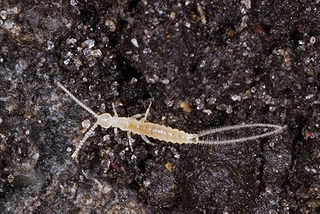
The order Diplura is one of three orders of non-insect hexapods within the class Entognatha. The name "diplura", or "two tails", refers to the characteristic pair of caudal appendages or filaments at the terminal end of the body.
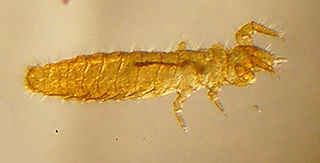
The Protura, or proturans, and sometimes nicknamed coneheads, are very small, soil-dwelling animals, so inconspicuous they were not noticed until the 20th century. The Protura constitute an order of hexapods that were previously regarded as insects, and sometimes treated as a class in their own right.

Earwigs make up the insect order Dermaptera. With about 2,000 species in 12 families, they are one of the smaller insect orders. Earwigs have characteristic cerci, a pair of forcep-like pincers on their abdomen, and membranous wings folded underneath short, rarely used forewings, hence the scientific order name, "skin wings". Some groups are tiny parasites on mammals and lack the typical pincers. Earwigs are found on all continents except Antarctica.

Forficula auricularia, the common earwig or European earwig, is an omnivorous insect in the family Forficulidae. The European earwig survives in a variety of environments and is a common household insect in North America. The name earwig comes from the appearance of the hindwings, which are unique and distinctive among insects, and resemble a human ear when unfolded; the species name of the common earwig, auricularia, is a specific reference to this feature. They are considered a household pest because of their tendency to invade crevices in homes and consume pantry foods, and may act either as a pest or as a beneficial species depending on the circumstances.
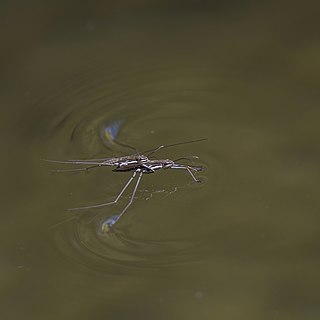
The Gerridae are a family of insects in the order Hemiptera, commonly known as water striders, water skeeters, water scooters, water bugs, pond skaters, water skippers, or water skimmers. Consistent with the classification of the Gerridae as true bugs, gerrids have mouthparts evolved for piercing and sucking, and distinguish themselves by having the unusual ability to walk on water, making them pleuston (surface-living) animals. They are anatomically built to transfer their weight to be able to run on top of the water's surface. As a result, one could likely find water striders present in any pond, river, or lake. Over 1,700 species of gerrids have been described, 10% of them being marine.

Labidura riparia is a species of earwig in the family Labiduridae characterized by their modified cerci as forceps, and light tan color. They are commonly known as the shore earwig, tawny earwig, riparian earwig, or the striped earwig due to two dark longitudinal stripes down the length of the pronotum. They are sometimes wrongly referred to as Labidura japonica, although said species is actually a subspecies, Labidura riparia japonica, found only in Japan. L. riparia are a cosmopolitan species primarily in tropical to subtropical regions. Body size varies greatly, ranging from 16 mm to 30 mm, with 10 abdominal segments. Males and females differ in forcep size, with males having much larger and stronger curve, while females have smaller, straighter forceps with a slight curve at the end. Earwigs use these forceps to assist in predation, defense, sexual selection, courting and mating, and wing folding.
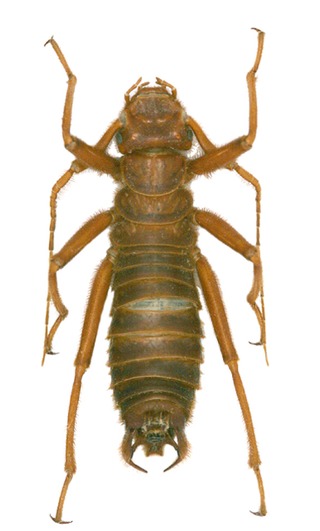
Arixenia esau is a species of earwig in the genus Arixenia. It is in the family Arixeniidae, a group composed solely of ectoparasitic earwigs. Like most other species in Arixeniidae, A. esau is found in the tropics of Indonesia and Malaysia and has only been collected on the island of Borneo. The species is heavily associated with its host the hairless bat and is most commonly collected from the fur of these bats and from caves inhabited by them. Arixenia esau is a rare species and has only been observed infrequently in its natural habitat.
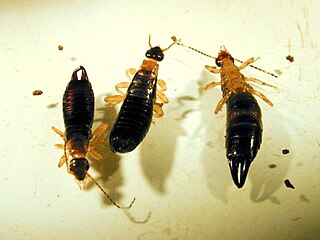
Euborellia is a genus of earwigs in the subfamily Anisolabidinae. It was cited by Srivastava in Part 2 of Fauna of India. Euborellia are small, dark-colored earwigs. Species can be difficult to distinguish from one another. There are about 50 species.
Euborellia plebeja is a species of earwig in the family Anisolabididae. Like other members of the Anisolabididae family, this species has an elongated virga, a sclerotized tube that is part of the male genitalia.
Euborellia brunneri is a species of earwig in the family Anisolabididae.

Progomphus borealis is a species of dragonfly in the family Gomphidae. This dragonfly species is commonly known as the gray sanddragon.

Gomphurus externus, the plains clubtail, is a species of dragonfly in the family Gomphidae.

Achrioptera fallax is a stick insect species found in Madagascar.
Hapljapyx is a genus of diplurans in the family Japygidae.

Chelisoches morio, also known as the black earwig, are part of the family Chelisochidae. It is an omnivore that can be found worldwide, however it is most prominent in tropical areas, Pacific islands, the Pacific Northwest, and damp environments. The adults are jet black and can range in size from 18 to 25mm in size, though some have grown to be 36mm. The males cerci are widely separated and serrated compared to the female. The forceps are used for prey capture, defense, fighting and courtship.
Most insects reproduce oviparously, i.e. by laying eggs. The eggs are produced by the female in a pair of ovaries. Sperm, produced by the male in one testis or more commonly two, is transmitted to the female during mating by means of external genitalia. The sperm is stored within the female in one or more spermathecae. At the time of fertilization, the eggs travel along oviducts to be fertilized by the sperm and are then expelled from the body ("laid"), in most cases via an ovipositor.
Toxolabis is an extinct genus of earwig in the dermapteran family Anisolabididae known from a Cretaceous fossil found in Burma. The genus contains a single described species, Toxolabis zigrasi.
Dolania is a monotypic genus of mayfly in the family Behningiidae containing the single species Dolania americana. It is found in the southeastern United States, as far south as Florida, and is generally uncommon. The adult insects emerge before dawn in early summer, mate and die within the space of about thirty minutes. The female deposits her eggs in the water and dies within five minutes of emergence, believed to be the shortest adult lifespan of any insect.
Usazoros hubbardi, commonly known as Hubbard's angel insect, is a species of insect in the order Zoraptera. It is native to the tropical and subtropical New World and has expanded its range into the eastern United States, where it lives in piles of sawdust, whereas in the hotter part of its range it lives under the bark of decomposing logs. It was named after the American entomologist Henry Guernsey Hubbard, who discovered the insect in the United States.
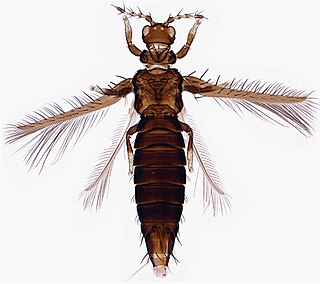
Selenothrips rubrocinctus, commonly known as the redbanded thrips, is a species of thrips in the family Thripidae. It was first described from the West Indies but may have originated in northern South America. It has spread to other parts of the world and now has a near pan-tropical distribution, occurring in North, Central, and South America, Africa, southern Asia, and Australasia.














